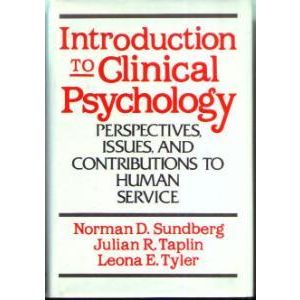Introduction
TO
Clinical
Psychology PERSPECTIVES,
ISSUES, AND
CONTRIBUTIONS TO
HUMAN
SERVICE Hardback book with Dust Jacket by Norman D. Sundberg, Julian R. Taplin, Leona E. Tyler Over 495 pages © 1983 by Prentice-Hall, Inc. " What fundamental principles and concepts does psychology have to offer
that are useful in the human service professions? " " What knowledge is needed from the broad field of
clinical psychology? " " The answers to these questions are central to
Introduction to Clinical Psychology
as it presents a knowledge base for people whose work involves helping other people.
These include students who are preparing for any of the varied occupations such as clinical, counseling or community psychology, or community psychology, or other human services, such as nursing, social work, medicine, juvenile or adult corrections, the ministry, or education.
For those already planning to be professional psychologists, there are provisions for going into the topics in more depth.
For those already working in the human service professions, the book provides an updating of psychological knowledge. " " To show that clinicians can view problems and ideas from different perspectives, the authors have identified four major orientations:
a curative, or psychopathological view;
a learning perspective, both behavioral and cognitive;
a growth, or developmental, concern;
and an ecological orientation emphasizing the embedding of persons in larger environments. " " They also address helping at various system levels - the psychobiological, individual, family and small group, organizational, and community levels.
They are particularly concerned that the human services take a long-range view into the future. " Summary of Contents includes: " Preface I INTRODUCTION AND BASIC CONCEPTS 1 Clinical Psychology: What Is It? 2 Useful Ideas about People: Theoretical Perspectives 3 Helping without Harming: Designs and
Decisions for Intervening in Human Lives II PRINCIPLES OF CLINICAL ASSESSMENT 4 Obtaining Useful Information: The Assessing Process 5 Using Psychological Tools: Testing for Ability,
Personality, and Behavior 6 The Uses of Information: Interpreting and
Communicating Findings III INTERVENTION AT DIFFERENT SYSTEM LEVELS 7 Taking the Body into Account: The Integration of
Biological and Psychological Knowledge 8 Working with Individuals: Psychoanalysis and
Psychodynamic Approaches 9 Working with Individuals: Behavioral and
Cognitive Approaches 10 Getting One's Bearings: Choosing, Planning,
Growing, through Counseling 11 Working with Couples and Families: Marital and
Family Therapies 12 Working With Groups, Organizations and Communities IV THE PLACE OF CLINICAL WORK IN LARGER CONTEXTS 13 Being Accountable: Evaluation, Research, and the
Furtherance of Knowledge 14 The Larger Questions: Issues for Professionals,
Society, and the Future References
Name Index
Subject Index " This book is in excellent condition with only very minor wear.
The dust jacket has some wear and tear around the edges.
No torn or ripped pages.
No markings or writing. | 





 for 1 item(s)
for 1 item(s)








![Aries Zodiac Black Round Watch [40209985]](https://pic.ebid.net/upload_small/8/1/0/1562677293-12830-33.jpg)








